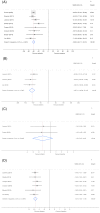Efficacy and safety of radiofrequency ablation for hypertrophic obstructive cardiomyopathy: A systematic review and meta-analysis
- PMID: 32034788
- PMCID: PMC7244291
- DOI: 10.1002/clc.23341
Efficacy and safety of radiofrequency ablation for hypertrophic obstructive cardiomyopathy: A systematic review and meta-analysis
Abstract
Background: Although radiofrequency ablation is widely used in the treatment of arrhythmias, its role in septal reduction therapy of hypertrophic obstructive cardiomyopathy (HOCM) is unclear. This meta-analysis aimed to assess the efficacy and safety of radiofrequency septal ablation for HOCM.
Hypothesis: Radiofrequency septal ablation is effective and safe for relieving obstruction and improving exercise capacity in patients with HOCM.
Methods: A systematic review of eligible studies that reported outcomes of patients with HOCM who underwent radiofrequency septal ablation was performed using PubMed, Embase, Cochrane, ProQuest, Scopus, ScienceDirect, and Web of Science database. Pooled estimates were calculated using random-effects meta-analysis. Methodological quality was assessed using the Newcastle-Ottawa scale. Publication bias and sensitivity analyses were also performed.
Results: Eight studies with 91 patients (mean follow-up 11.6 months) were included. The left ventricular outflow tract (LVOT) gradient at rest decreased significantly after radiofrequency septal ablation (pooled reduction: -58.8 mmHg; 95% confidence interval [CI] -64.3 to -53.5). A reduction was also found in the provoked LVOT gradient with a pooled reduction of -97.6 mmHg (95% CI: -124.4 to -87.1). An improvement of the New York Heart Association classification (mean: -1.4; 95% CI: -1.6 to -1.2) was found during follow-up. The change in septal thickness was minimal and not statistically significant. Two procedure-related deaths were documented, and complete heart block occurred in eight patients.
Conclusions: Radiofrequency septal ablation is effective and safe for relieving LVOT obstruction and improving exercise capacity in patients with HOCM.
Keywords: hypertrophic obstructive cardiomyopathy; meta-analysis; radiofrequency ablation; septal reduction therapy.
© 2020 The Authors. Clinical Cardiology published by Wiley Periodicals, Inc.
Conflict of interest statement
The authors declare no potential conflict of interests.
Figures



References
-
- Elliott PM, Anastasakis A, Borger MA, et al. 2014 ESC guidelines on diagnosis and management of hypertrophic cardiomyopathy: the task force for the diagnosis and Management of Hypertrophic Cardiomyopathy of the European Society of Cardiology (ESC). Europ Heart J. 2014;35(39):2733‐2779. - PubMed
-
- Cooper RM, Raphael CE, Liebregts M, Anavekar NS, Veselka J. New developments in hypertrophic cardiomyopathy. Can J Cardiol. 2017;33(10):1254‐1265. - PubMed
-
- Maron BJ, Maron MS, Wigle ED, Braunwald E. The 50‐year history, controversy, and clinical implications of left ventricular outflow tract obstruction in hypertrophic cardiomyopathy: from idiopathic hypertrophic subaortic stenosis to hypertrophic cardiomyopathy. J Am Coll Cardiol. 2009;54(3):191‐200. - PubMed
Publication types
MeSH terms
LinkOut - more resources
Full Text Sources

